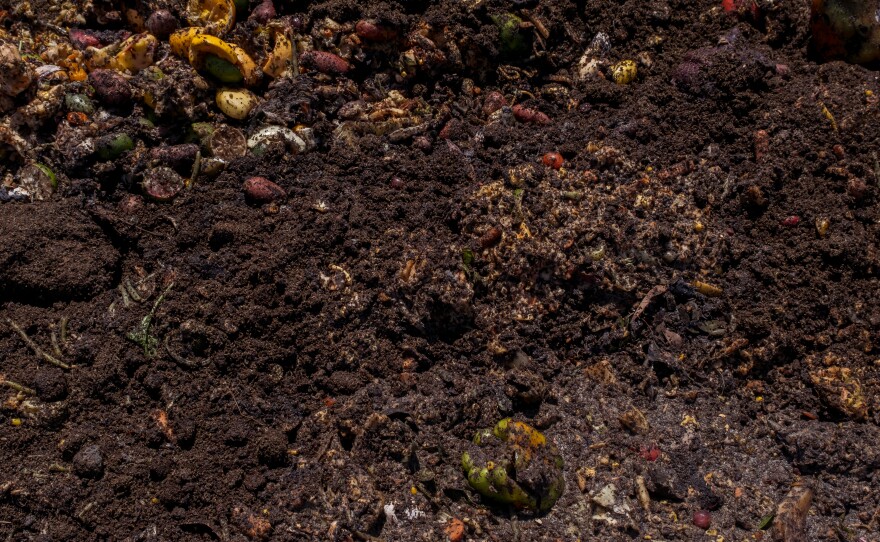“So this is where we keep our green bin, right next to the coffee and sink,” said Keri Libby-Legett, a resident of the Rolando neighborhood of San Diego.
She is just one of many San Diego residents getting acquainted with the stinky, smelly part of their garbage, as organic recycling expands.
The plastic caddy that Keri lifts off her counter is full. It is holding coffee grounds, banana peels, and most of a sandwich her son could not be convinced to eat.
This organic waste is what San Diego officials are asking residents to separate from their other trash and recyclables.
Instead of just a brown and blue bin, Legett also has a new green bin which city officials said is made with recycled material.
“Alright, so this is our green waste bin and right now it is about half way full with leaves and other green waste that I’ve picked up throughout the week,” Legett said as she opened the lid and looked inside.
The stinky rotting stuff that used to be contained inside a plastic bag before the change is now under leaves raked up from the yard. There is no smell or flies.
A wet winter means greenery to cover up the waste is easy to come by now, but Legett wonders how that will work later in the year when yard trimmings become more scarce.
Her husband, Christian Legett is enthusiastic, but he also worries about bugs and rodents.
“There’s flies. There’s mold. It stinks,” Christian said. “But honestly, the juice has been more worth the squeeze for us. Just to kinda know that we’re able to have some sort of a positive impact. It’s a minor inconvenience.”
The Legetts’ have embraced the city’s state mandated organic waste program enthusiastically, a response San Diego officials hope to see from everyone.
The city is turning that waste and yard trimmings into compost as part of an effort to reduce climate warming methane emissions that come from landfills. And, so far, the amount of green waste composted at the Miramar Landfill is up sharply this year compared to last year.

“We’ve done over 12,000 tons in this new program and that’s with 104 routes online,” said Renee Robertson, the director of San Diego’s Environmental Services Department. “So, we’re really seeing a significant amount of material that must have been in the trash bin coming into the organic waste bins.”
Robertson concedes that this year’s wet winter may have created extra yard trimmings, likely accounting for much of that increase. But she said keeping yard waste out of the landfill is important too.
But separating food scraps from the regular trash is the biggest change because of the yuck factor.
“At first it was a little bit mind boggling. It was like, oh, I need to line it or I need to do something because yeah if you put the coffee grounds into the little pail, you empty the pail, then the coffee grounds are going to go everywhere."Adrienne Hotaling, College Area resident
Wrapping waste in old newspaper or paper towels can help contain the mess, but decomposing food is decomposing food.
“If you’re metering and putting your food waste into the green bin throughout the week it’s going to start, it's decomposing as soon we make those cuts, right?” Robertson said. “So keeping it refrigerated or under your sink in a cool environment will reduce all of that.”
Robertson said planning helps. Some people even freeze food waste before taking it out on garbage day. For people who feel intimidated by the new requirements, Robertson suggests starting slow. Separating coffee grounds, fruit peels and vegetable scraps from other waste is a good place to start and it can develop good habits.
“Eventually we’ll get to the point where everybody is participating and putting everything in, but we expect that to take years and we want people to feel comfortable starting small with what’s manageable for them,” Robertson said.

But California may not have the luxury of easing into the program. The state is rapidly approaching a 2025 deadline to divert 75% of the state’s organic waste from landfills.
The Little Hoover Commission — a state advisory board — is suggesting California put a temporary pause on the ambitious effort to reduce methane emissions at landfills.
The commission found the state missed the 50% reduction by 2020 goal and it is unlikely to do better by 2025. The panel points out that half of the communities in the state are not even participating in organic waste recycling.
The 2016 law took effect at the beginning of 2022 and it does include fines for municipalities and individuals who do not participate.
It remains to be seen how the state of California will respond to the commission’s report. But for San Diego residents lofty climate goals are not the primary concern.
Adrienne Hotaling lives in the College Area near San Diego State University. She said some of her neighbors are taking part and some are not. She uses the pail and a leak-resistant paper bag in the fridge to store the waste until trash pickup day.
“At first it was a little bit mind boggling,” Hotaling said. “It was like, oh, I need to line it or I need to do something because yeah if you put the coffee grounds into the little pail, you empty the pail, then the coffee grounds are going to go everywhere. And then someone’s going to have to clean up that big trash can.”
San Diego officials hope that a long-term goal of helping the environment wins out over the short-term discomfort of dealing with smelly food scraps.







